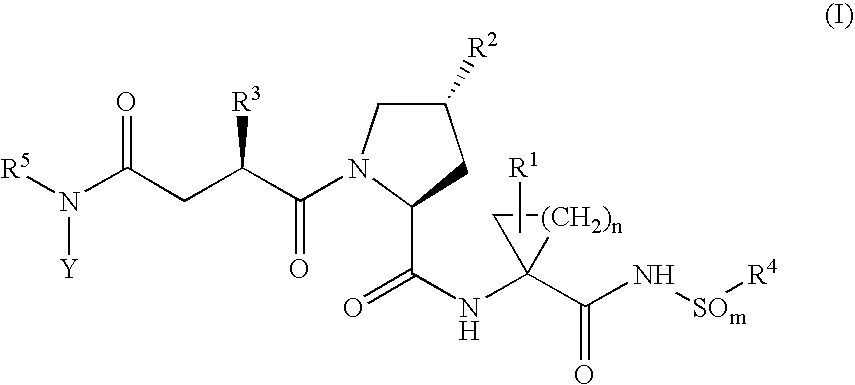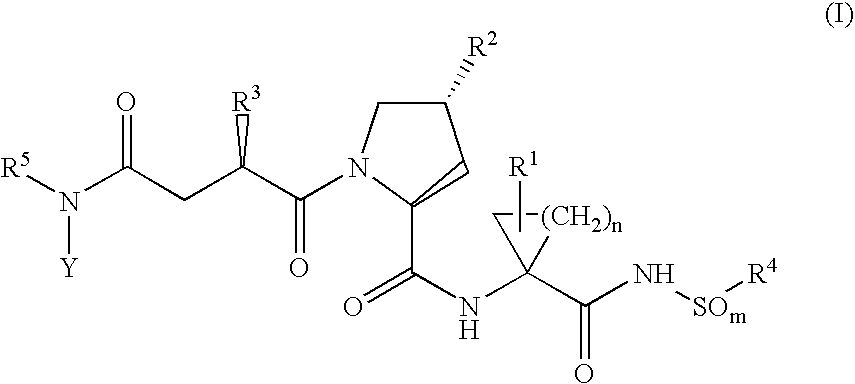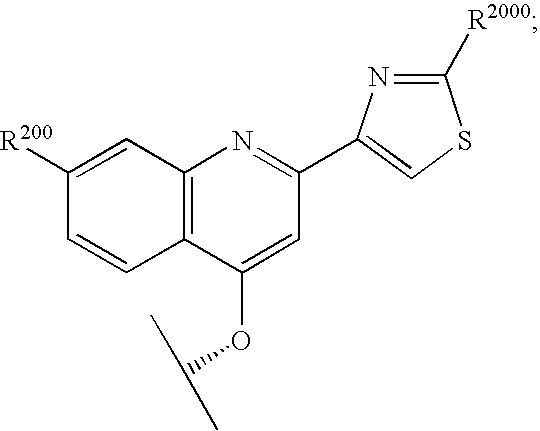Hepatitis C inhibitor peptide analogs
a technology of hepatitis c and peptides, applied in the field of hepatitis c inhibitor peptide analogs, can solve the problems of lack of effective treatment, lack of cellular and humoral immune responses in protecting against hcv infection and disease, and the recommendation of immunoglobulin treatment, etc., and achieves the effect of not showing significant inhibitory activity
- Summary
- Abstract
- Description
- Claims
- Application Information
AI Technical Summary
Benefits of technology
Problems solved by technology
Method used
Image
Examples
example 1a
Synthesis of P2 Building Block 2-methyl-3-methoxy aniline (1A2)
[0493]
[0494] To a solution of 2-methyl-3-nitro anisole which is commercially available (1a1) (5.1 g; 30.33 mmol; requires ˜30 min. to dissolve) in absolute ethanol (85 mL) was added 10% Pd / C catalyst (500 mg). The solution was hydrogenated under a hydrogen filled balloon at atmospheric pressure and room temperature for 19 h. The reaction mixture was filtered through a Celite pad, rinsed and evaporated to dryness to obtain the compound 1a2 as a deep mauve oil (4.1 g; 29.81 mmol; 98% yield). MS 137 (MH)+. Reverse Phase HPLC Homogeneity@220nm (0.06% TFA;CH3CN;H2O): 99%.
example 1b
Synthesis of P2 Moiety 2-bromo-3-methoxy aniline (1B4)
[0495]
[0496] Step A: 2-Amino-3-nitrophenol 1b1 (5 g; 32.4 mmol) was dissolved in H2O (29.5 mL) and 1,4-dioxane (14.7 mL). The mixture was heated to reflux and hydrobromic acid (48%; 16.7 mL; 147 mmol) was added dropwise over a period of 20 min. Upon completion of the addition, the reflux was maintained an additional 15 min. The reaction was cooled to 0° C. (ice bath), and sodium nitrite (2.23 g; 32.3 mmol) in H2O (20 mL) was added over a period of 30 min. The stirring was continued for 15 min. at 0° C., the mixture transferred to a jacketed dropping funnel (0° C.) and added dropwise to a stirred mixture of Cu(I)Br (5.34 g; 37.2 mmol) in H2O (29.5 mL) and HBr (48%; 16.7 mL; 147 mmol) at 0° C. The reaction was stirred for 15 min. at 0° C., warmed to 60° C., stirred for an additional 15 min., cooled to room temperature, and left to stir overnight. The reaction mixture was transferred to a separatory funnel and extracted with ether ...
example 1c
Synthesis of P2 Moiety 2-chloro-3-methoxy aniline (1c3):
[0499]
[0500] Step A: 2-Amino-3-nitrophenol 1b1 (5 g; 32.4 mmol) was dissolved in concentrated HCl (75 mL) and 1,4-dioxane (14.7 mL). The mixture was heated to 70° C. until most of the solids were in solution. The reaction mixture was cooled to 0° C. (ice bath), and sodium nitrite (2.23 g; 32.3 mmol) in H2O (5.4 mL) was added over a period of 3 hours to the brown solution. The temperature was maintained below 10° C. during the addition and the stirring was continued for an additional 15 min. at 0° C. This diazonium intermediate was poured into a solution of Cu(I)Cl (3.8 g; 38.9 mmol) in H2O (18.5 mL) and conc. HCl (18.5 mL) at 0° C. The reaction was stirred for 15 min. at 0° C., warmed to 60° C., and stirred for an additional 15 min. The reaction mixture was then brought to room temperature, and left to stir overnight. The reaction mixture was transferred to a separatory funnel and extracted with ether (3×150 mL). The organic l...
PUM
| Property | Measurement | Unit |
|---|---|---|
| temperature | aaaaa | aaaaa |
| temperature | aaaaa | aaaaa |
| temperature | aaaaa | aaaaa |
Abstract
Description
Claims
Application Information
 Login to View More
Login to View More - R&D
- Intellectual Property
- Life Sciences
- Materials
- Tech Scout
- Unparalleled Data Quality
- Higher Quality Content
- 60% Fewer Hallucinations
Browse by: Latest US Patents, China's latest patents, Technical Efficacy Thesaurus, Application Domain, Technology Topic, Popular Technical Reports.
© 2025 PatSnap. All rights reserved.Legal|Privacy policy|Modern Slavery Act Transparency Statement|Sitemap|About US| Contact US: help@patsnap.com



